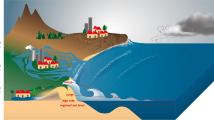Abstract
The Salt Water Intrusion Meetings, or SWIMs, are a series of meetings that focus on seawater intrusion in coastal aquifers and other salinisation processes. 2018 marks the 50th year of the SWIM and the 25th biennial meeting. The SWIM proceedings record half a century of research progress on site characterisation, geophysical and geochemical techniques, variable-density flow, modelling, and water management. The SWIM is positioning itself to remain a viable platform for discussing the coastal aquifer management challenges of the next 50 years.
Résumé
Les conférences sur l’intrusion d’eau salée, ou SWIM pour Salt Water Intrusion Meetings, sont une série de conférences qui s’intéressent à l’intrusion de l’eau de mer dans les aquifères côtiers et aux autres processus de salinisation. 2018 marque le 50ème anniversaire du SWIM ainsi que la 25ème réunion biennale. Les comptes rendus du SWIM documentent un demi-siècle de progrès en recherche sur la caractérisation des sites, les méthodes géophysiques et géochimiques, l’écoulement à densité variable, la modélisation et la gestion de l’eau. Le SWIM est bien positionné pour former une plate-forme d’échange viable concernant les défis de la gestion des aquifères côtiers pour les 50 prochaines années.
Resumen
Las Reuniones sobre la Intrusión de Agua Salada, o SWIMs, son una serie de reuniones que se centran en la intrusión de agua de mar en los acuíferos costeros y otros procesos de salinización. El año 2018 marca el 50° año de las SWIMs y la 25 ° Reunión Bienal. Las actas de las SWIM registran medio siglo de progreso de la investigación en la caracterización de sitios, técnicas geofísicas y geoquímicas, flujo de densidad variable, modelado y gestión del agua. El SWIM se está posicionando para seguir siendo una plataforma viable para los desafíos de gestión de acuíferos costeros para los próximos 50 años.
摘要
咸水入侵会议为一系列会议,这些会议聚焦沿海含水层中的海水入侵及其它盐化过程。2018年距首次召开咸水入侵会议已有50年,并且2018年还将召开第25次两年一次的会议。咸水入侵会议论文集记录了半个世纪以来场地特征描述、地球物理和地球化学技术、可变密度水流、模拟和水管理方面的研究进展。咸水入侵会议仍将把本身定位成下一个50年应对沿海含水层管理挑战的、充满活力的平台。
Resumo
Os Encontros Sobre Intrusão Salina (Salt Water Intrusion Meetings), ou SWIMs, são uma série de encontros que focam na intrusão salina em aquíferos costeiros e outros processos de salinização. 2018 marca o 50° ano de SWIM e o 25° ano do encontro bianual. Os anais do SWIM registram meio século de progressos na pesquisa em caracterização de sites, técnicas geofísicas e geoquímicas, fluxo de densidade variável, modelagem, e gestão de recursos hídricos. O SWIM encontra-se posicionando-se para permanecer como uma plataforma viável para os desafios no gerenciamento de aquíferos costeiros nos próximos 50 anos.

Similar content being viewed by others
References
Bauer P, Zimmermann S, Held R, Gumbricht T, Kinzelbach W (2002) Is density flow balancing the salt budget of the Okavango delta? Evidence from field and modelling studies. SWIM 17:309–321
Cotecchia V (1981) Methodologies adopted and results achieved in the investigations of seawater intrusion into the aquifer of Apulia (southern Italy). Geologisches Jahrbuch Reihe C 29:1–68
Custodio E (1992) Coastal aquifer salinization as a consequence of aridity: the case of Amurga phonolitic massif, Gran Canaria Island. SWIM 12:81–98
De Breuck W [editor] (1991) Hydrogeology of salt water intrusion: a selection of SWIM papers. International Contributions to Hydrogeology, vol 11, International Association of Hydrogeologists, Heise, Hanover, Germany, 422 pp
Dowgiałło J, Frączek E (1990) An attempt at the interpretation of new data on the Hel Spit hydrogeology (Poland). SWIM 11:5–14
Downing, RA (1972) A summary of saline intrusion problems in the United Kingdom. SWIM 3:70–74
Flathe N (1968) Stand der Kenntnisse über den Anwendungsbereich der Geolektrik im niedersächsischen Küstengebiet [State of knowledge on the scope of geolectics in the coastal area of Lower Saxony]. SWIM 1:6–9
Geyh MA (1968) 14C- und 3H-Konzentrationsbestimmungen [14C and 3H concentration determinations]. SWIM 1:16–19
Højberg AL, Hansen AL, Wachniew P, Żurek AJ, Virtanen S, Arustiene J, Refsgaard JC (2017) Review and assessment of nitrate reduction in groundwater in the Baltic Sea basin. J Hydrol: Region Stud 12:50–68
Klinge H, Boehme J, Ludwig R (1999) Fresh-water/salt-water distribution in the aquifer system above the Gorleben salt dome: results of the Gorleben site investigation programme. SWIM 15:172–177
Lebbe L (1981) The subterranean flow of fresh and salt water underneath the western Belgian beach. SWIM 7:193–219
Lindewald H (1981) Saline groundwater in Sweden. SWIM 7:24–32
Michael HA, Post VEA, Wilson AM, Werner AD (2017) Science, society, and the coastal groundwater squeeze. Water Resour Res 53(4):2610–2617. https://doi.org/10.1002/2017wr020851
Nielsen H (1968) Schwefelisotopen-Untersuchungen [Sulfur isotope studies]. SWIM 1:13–14
Ochmann N, Fielitz K (1993) Estimation of horizontal and vertical groundwater flow from well logging and pressure data in groundwater of variable density above a saltdome. SWIM 12:359–369
Scholten J, Kreuzburg M, Knoeller K, Rapaglia J, Schlüter M, Schubert M (2014) Submarine groundwater discharge in the southwestern Baltic Sea. SWIM 23:362
Schwerdtfeger B (1981) On the occurrence of submarine fresh-water discharges. Geologisches Jahrbuch Reihe C 29:231–240
Stahl W (1968) Sauerstoffisotopten: Untersuchungen [Oxygen isotopes: investigations]. SWIM 1:14–16
Sund B, Bergman G (1981) Sea water intrusion in drilled wells. SWIM 7:45–58
SWIM (2018) Salt Water Intrusion Meeting (SWIM). http://www.swim-site.org. Accessed January 2018
Szymczycha B, Pempkowiak J (2016) Research on Submarine Groundwater Discharge in the Baltic Sea. In: The role of submarine groundwater discharge as material source to the Baltic Sea. Springer, Heidelberg, Germany, pp 53–132
Verruijt A (1972) Analysis of interface problems by the finite element method. SWIM 3:53–59
Zechner E, Zidane A, Younes A, Huggenberger P (2014) Simulation of high-contrast density driven transport. SWIM 22:247–250
Zuber A, Kozerski B, Sadurski A, Kwaterkiewicz A, Grabczak J (1990) Origin of brackish waters in the Quaternary aquifer of the Vistula delta. SWIM 11:249–262
Author information
Authors and Affiliations
Corresponding author
Additional information
This article is part of the topical collection “Celebrating 50 years of SWIMs (Salt Water Intrusion Meetings)”
Electronic supplementary material
ESM 1
(PDF 301 kb)
Rights and permissions
About this article
Cite this article
Post, V.E.A., Oude Essink, G., Szymkiewicz, A. et al. Celebrating 50 years of SWIMs (Salt Water Intrusion Meetings). Hydrogeol J 26, 1767–1770 (2018). https://doi.org/10.1007/s10040-018-1800-8
Received:
Accepted:
Published:
Issue Date:
DOI: https://doi.org/10.1007/s10040-018-1800-8




